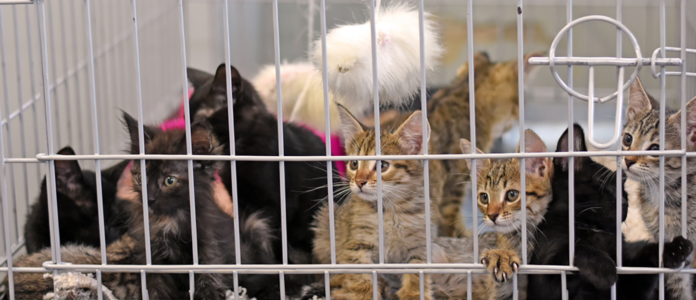Whether you want to adopt a cat or volunteer for a shelter or rescue group, checking out a new group can come with some surprises. Many rescue operations, whether they are a local animal shelter, private rescue group, or an individual with a penchant for rehabilitating cats in need, do an excellent job. The cats in their care receive medical attention as needed, are well-fed, housed in a safe and clean setting, and are adopted out as soon as possible to loving homes. But other operations get in over their heads and may leave you feeling a bit uncomfortable and concerned about the cats’ well-being.
Red Flags
“Many rescue groups and shelters out there operate beyond their capacity to care for animals on a regular basis,” says Lena DeTar, DVM, DACVPM, DABVP-SMP, Assistant Clinical Professor in Maddie’s Shelter Medicine Program at the Cornell University College of Veterinary Medicine.
“However, when it comes down to it, they are usually aware of that fact. These groups may struggle to make ends meet on donations and volunteer labor, may put up with overcrowding because they think they’re saving more animals if they don’t turn any away, may lack ready access to veterinary care, lack behavior or enrichment programs, may feel strongly that animals shouldn’t be euthanized, and hang onto hope that donors or adopters or transport partners will step up to help them keep their heads just above water. Education, access to grants and other funding, and minimizing unnecessary barriers to adoption can often significantly help these organizations
“The difference between these situations and hoarding is that hoarders have a hard time accepting that the animals in their care are suffering, even when they are on death’s doorstep. They often don’t see how the overcrowded unsanitary conditions, usually due to overflow of pet urine and feces, adversely affect the animals’ health and their own. They are often extremely unwilling to part with animals, even to good homes, when available,” says Dr. DeTar.
“Hoarders may go looking for more animals even when they are totally over capacity, may allow their population to breed unchecked, and may also retain bodies of dead animals, either as sentimental objects or because they don’t see them behind all the clutter.
“Hoarding tendencies range from mild to severe: It’s a complicated psychology that often includes aspects of obsessive-compulsive disorder, attachment disorder, and mental processing difficulties. Some people who hoard animals can be extremely charismatic and attract a following of dedicated enablers working at their rescues or sanctuaries,” says Dr. DeTar.
Scoping It Out
Get some background information before committing to adopting a new cat. Go in with open eyes when volunteering for a shelter or rescue group. If you are adopting, you want to have an accurate idea of the cat’s temperament and health status (you might be up to the task of a special needs kitty, but the rescue should be up front about the cat’s needs and issues). If you are volunteering, be honest with yourself about the conditions in the facility and whether the cats are being properly cared for. You are just one person, and while your contribution will help, a poorly managed rescue operation can quickly turn into a case of neglect.
Determining whether a person or group is a legitimate rescue helping cats versus a hoarding situation masquerading as a sanctuary can be challenging. Dr. DeTar says, “Slick social media portrayals may not accurately reflect how animals are actually housed or cared for.” She advises considering three things before volunteering for or donating to a shelter or rescue organization:
How are the animals cared for? Animals should be kept in a clean space free from their waste, offered fresh food and water daily, receive prompt treatment for medical problems, and not feel distressed by their environment.
Basic preventive medical care should be provided by the rescue and spay/neuter should be promoted or provided. A quick site visit can probably determine this (use your nose!), but a video tour can be helpful if that is not possible. Talk to other volunteers and adopters. Determine how healthy the animals appear to be.
What is the adoption process like? Animals entering the shelter or rescue should have a reasonable turn-around time to adoption, usually under a month or two on average for adults. (Of course, many cats will go much faster and some much slower. Faster is better.) It should be a relatively easy process to adopt a pet from the organization, and they should be eager for people to do so.
What is the euthanasia process? Just like cat owners, rescue organizations with animals that are suffering significantly from serious behavioral or end-stage medical conditions should be prepared to make the difficult decision to euthanize if treatment is no longer possible. The welfare of the animal should be the primary consideration; “no kill” should not be interpreted to mean “never euthanize.” Dr. DeTar says, “If the euthanasia rate at a shelter is 0%, it makes me very nervous.”
In-person visits may not be an option at this time due to COVID, even to meet a prospective new pet. This makes evaluations even more challenging. If you are not able to visit the rescue yourself, Dr. DeTar recommends talking to someone who has worked closely with the organization to get a good idea about how it is run. Larger organizations may also have public annual reports that you can review.
Reporting Hoarding
If the rescue seems to be in over its head but the people are truly trying to do right by the cats, do what you can to steer them in the right direction. Maddie’s Shelter Medicine Program at Cornell University (vet.cornell.edu/hospitals/maddies-shelter-medicine-program/shelters/shelter-resources) has a variety of resources available on their website, including options for a consultation to help your shelter or rescue be the best that it can be. But if the conditions are awful and the cats are suffering, intervention is necessary.
“The result of true hoarding situations is animal neglect, which is a crime, but human suffering is also occurring,” says Dr. DeTar. “If you suspect that a person or an organization is hoarding animals (i.e., they have more than the normal number of animals, that both the animals and humans are suffering because of it, and they are unwilling to seek help or reduce their population size), you should contact the Humane Investigations team at your local SPCA or Humane Society. If that does not exist or is not possible, call the non-emergency police tip-line or fill out an online crime report on your municipalities’ law enforcement website.
“In some places, governmental human services departments may offer hoarding assistance, and social workers may also advertise their services. Any of these resources can help get the ball rolling on the appropriate intervention,” says Dr. DeTar.
Judging a Rescue Group
You need to go in with your eyes wide open and look at the situation
Good Signs
- Cats appear happy and healthy
- Facility is clean and has minimal odor
- Rescue has a working relationship with at least one veterinary facility
- Adoption policies are in place
- Enrichment programs to keep cats mentally stimulated
- Organized staff and/or volunteer base
- Track and limit intake
- Euthanizes cats that are ill and suffering or are unfit to be rehomed
Potential Issues
- Cats show mild-moderate signs of stress or illness
- Cat living spaces and litter boxes show signs of infrequent cleaning
- Crowded conditions
- Doesn’t track number of cats in the facility and/or no limit to intake
- Has difficulty accessing veterinary care
- No enrichment programs
- Insufficient staff and poor volunteer base
- Resists euthanasia in all cases
- Excessive or unrealistic requirements to adopt
Major Red Flags
- Large percentage of sick cats
- Little or no veterinary care provided
- Unsanitary living conditions
- Strong odor due to urine and feces
- Crowded conditions
- Uncontrolled breeding
- Resists euthanasia in all cases
- Dead cats
- Unwilling to adopt cats out




